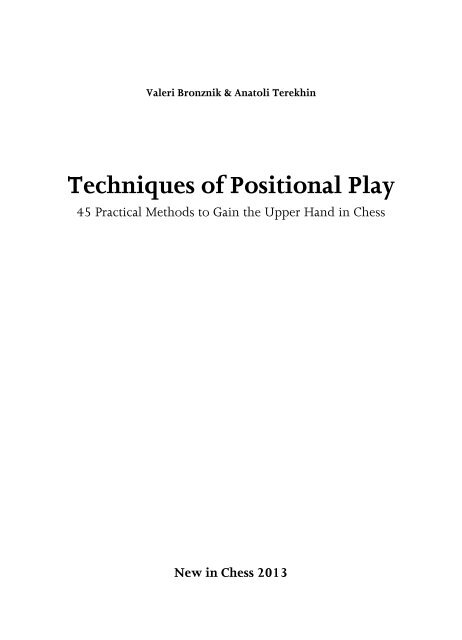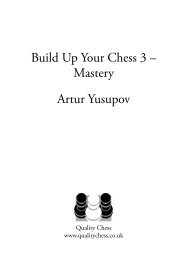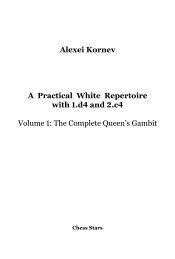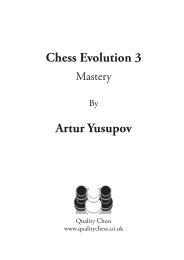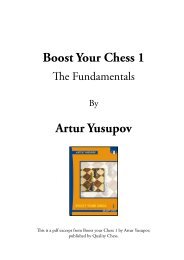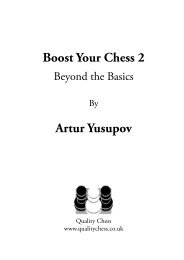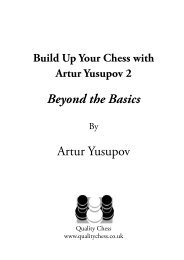Download sample pages. (pdf) - New In Chess
Download sample pages. (pdf) - New In Chess
Download sample pages. (pdf) - New In Chess
You also want an ePaper? Increase the reach of your titles
YUMPU automatically turns print PDFs into web optimized ePapers that Google loves.
Techniques of Positional Play<strong>In</strong> addition the reader of the Germanresp. English edition will find significantlymore analysis and explanationsthan there were in the Russian original.Nevertheless the main emphasis in thisbook was not laid on deep analysis, butrather on giving you as good as possiblea feeling for and understanding of theideas and methods which are presented.Consequently I have deliberately tried toavoid, where possible, complicated andconfusing analyses.Firstly, a little caution: in this book youwill be confronted with new conceptswhich may at first glance appear strange,for example the aforesaid ‘potentialpassed pawn’ or the ‘wave-breaker’ orthe ‘pendulum manoeuvre’. These expressionsare inventions of A. Terekhin,and we have translated them to the bestof our ability. Whenever you encountereach such technique the concepts willthen be explained in greater depth.The overwhelming number of examplescomes from the creative work of worldfamous players. But there are also extractsof games played by less well-knownpeople, whose names you may perhapsnot know. That proves that it is notnecessary to be a GM or even an IM todemonstrate successful use of a strategicidea. And a good thing it is too!I must thank Anatoli Terekhin for havingappreciated my work and making noobjection to allowing me to stand as hisco-author for the German and Englishedition.IM Valeri BronznikStuttgart, August 2005Dear reader,When Valeri Bronznik showed me theinconspicuous little Russian book byTerekhin, I was immediately affected ina very special way. It is not that no goodmiddlegame books had previously appeared– sterling service in this field hasbeen done above all by Dvoretsky andWatson. No, for some reason there appearedto be specific and not so peculiarlycomplicated artifices with which I hadnever become systematically acquainted,but which I had come up against infragmentary and painful fashion in myencounters with strong players.The idea occurred immediately that thebook had to be published in German,though it was clear that for a publicationwhich would come up to Western standards– and I am not just talking aboutthe translation – some fine-tuning wasstill required. Following the proverb‘Too many cooks spoil the broth’ I alsobecame involved with the work, changingthe order of the techniques andarranging them in individual chapters,putting together a chapter with exercisesdrawn from ‘superfluous’ examples, etc.The result – a tribute to the Germanpenchant for systematising – is that thefirst four chapters are devoted above allto the art of pawn play, chapters V to Xon the other hand to piece play. Withappropriate reservations, of course.I wish the readers a whole host of instructivemoments!FM Harald Keilhack, editorSchwieberdingen, Nov.2005/July 20138
Chapter IRestricting the enemy pieces‘If one piece is badly placed, then your whole game is bad’The whole of the first chapter is devoted to this adage from the Russian chess school.It illustrates different techniques for excluding an opposing piece from the action bymeans of clever pawn play and it presents the subtle consequences of this – whichsometimes reach far into the endgame.Putting the knight in chainsTechnique No. 1I. Paralysing the knight with the duo of wing pawnsWe start with the surprisingly frequent motifof restricting a knight by the wing pawns:§g3/§h4 against a ¤g6 is the main subjectwith various mirror image variations.The opponent is frequently faced with achoice only between different evils:Opposing with his own rook pawn (...h5or ...a5) creates weaknesses or is notreally possible. Allowing h4-h5 or a4-a5leaves him at a disadvantage in space,and for the rest of its days the knight canoften never find a good square. 1.1 Botvinnik–BoleslavskyMoscow (USSR Ch) 1941XIIIIIIIIY9-+-+-trk+09+-+r+pzpp09-zpq+-+n+09zp-+p+-+-09P+-zP-+-+09+-zPNtRQ+-09-zP-+-+PzP09+-+-tR-mK-0 xiiiiiiiiyThe last move was 24...£d6-c6.‘Black wants to tie in one of theopposing pieces to the protectionof the §a4. <strong>In</strong> that case the developmentof White’s initiative wouldslow down. But White has at hisdisposal a clear attacking plan:drive away the ¤g6 so as to gainaccess to the e7-square for his rookand to the e5- and f4-squares forthe knight. For that reason Whiteignores the petty threat posed byhis opponent’ (Botvinnik).25.g3! ¦d6The continuation 25...£xa4 26.h4 wasextremely dangerous for Black, e.g. 26...¦d6 (or 26...¦fd8 27.h5 ¤f8 28.h6,and according to Botvinnik White’sattack plays itself) 27.h5 ¤h8 28.¤f4±.26.h4! f6So as to control the e5-square.27.£f5! £c827...£xa4 was quite bad on account of28.h5 ¤h8 29.¤f4, e.g. 29...¤f730.¤e6! ¦b8 31.£g4 ¤g5 32.¤xg59
Techniques of Positional Playfxg5 33.¦e7 h6 34.£f5+− or 29...£d730.£xd7 ¦xd7 31.¦e7 ¦xe7 32.¦xe7¤f7 33.¤xd5+−.28.£xc8 ¦xc8 29.h5 ¤f8 30.¦e7¦cd830...¦c4 31.¦b7 ¦xa4 32.¦ee7+−.31.¤f4±,and White won on move 49. 1.2 Tamburini–BotvinnikLeipzig (Olympiad) 1960XIIIIIIIIY9-+lwqr+kvl0 9tr-+-+n+p09pzp-zp-snp+09+-zpP+p+-09-+P+-+-+09+-sN-vLPsN-09PzP-wQL+PzP09+R+R+-mK-0xiiiiiiiiyBefore looking at the further course ofthe game, I should like to draw yourattention to Black’s queen’s rook, whichis ready to pop up on the e-file in asingle move – we shall delve moredeeply into this idea and similar onesunder Technique No. 32, ‘The rooklift.’21...h5!∆...h5-h4, ...¤f6-h5.22.¥f1 h4 23.¤ge2 ¤h5A further gain of space on the kingside isthe threat after ...g6-g5, ...f5-f4, whenthe ¥c8 becomes active; in addition the¥h8 is now no longer blocked and canthus exert strong pressure along the longdiagonal.As far as White’s position is concerned,one can sense a certain lack of harmony– the constellation ¤e2/¥f1 looks reallyunnatural. The game ended surprisinglyquickly.24.¤f4??Of course White’s desire to swap off hisbadly posted knight is an easy one tofulfil, but ...24...¤xf4 25.¥xf4 ¥d4+ 0-1After 26.¢h1 g5 White loses the ¥f4.So there was no longer any need for therook lift to e7 – White had already abandonedhis position. 1.3 Petrosian–BotvinnikMoscow (1st WCh game) 1963XIIIIIIIIY9rsnl+r+k+0 9zpp+-+pzp-09-+p+-wq-zp09+-+p+-+-09-+-zP-+-+09zP-wQ-zP-sN-09-zP-+-zPPzP09tR-+-mKL+R0xiiiiiiiiyWhite has at his disposal the usual planof the minority attack on the queenside(b2-b4-b5). And what about Black’scounterplay?12...g6!<strong>In</strong>tending ...h6-h5-h4.13.f3?!As Botvinnik writes in his notes on thisgame, the only possible reason for thismove is as preparation for queensidecastling – the pawn would otherwise beleft hanging on f2.Of course there would be another reasonfor 13.f3, namely to prepare e3-e4. Butfor the moment that does not look like arealistic option and in fact in the futurecourse of the game White manages neither10
Chapter IICreate breathing space for your pieces!<strong>In</strong>stead of, as in the previous chapter, restricting opposing pieces, the discussion is nowabout the activation of our own pieces or how the pawns are used for that.They can either sacrifice themselves ( Technique Nos. 8-9), blasting open outposts(Technique No. 10) or securing them ( Technique No. 11).Technique No. 8The temporary pawn sacrificeNow, the temporary pawn sacrifice. Everychess player knows that in the Queen’sGambit the c-pawn is not really sacrificed;or there are cases where one offers theb-pawn in the knowledge that ¥:§b7 isalways followed by ...¦b8 and ...¦:§b2.Here are some less trivial examples: 8.1 Alekhine–TartakowerDresden 1926XIIIIIIIIY9rsnltr-+k+09zpp+-+-+p09-+-zp-+psn09+-zpPzppsN-09-+-+P+-+09+-sNL+-+P09PzPP+-zPP+09tR-+-mK-+R0 xiiiiiiiiyWhite has the more active position and alead in development. Consequently heshould open the centre, but the natural12.0-0 (∆13.f4) is followed by 12...f4or even first 12...¤a6 (∆...¤b4) 13.a3f4, and the centre would remain closed.12.f4!This pseudo-sacrifice allows Alekhine toachieve his aim. He first forces the openingof the centre and only then does he castle.12...exf4 13.0-0The §f4 cannot be protected.13...¤a6 14.¦xf4 ¤b4 15.¦h4± 8.2 Nimzowitsch–Capablanca<strong>New</strong> York 1927XIIIIIIIIY9rsnlwq-trk+0 9zppzp-vlpzpp09-+-+psn-+09+-+p+-+-09-+PzP-+-+09+-+LzPN+-09PzP-sN-zPPzP09tR-vLQmK-+R0xiiiiiiiiyHow should Black continue here? 6...¤c6is scarcely worth considering – Black woulddeprive himself of the resource ...c5. Ofcourse Black could continue with ...¤bd7,but Capablanca wants to bring about amore active position for this knight.50
Chapter II – Create breathing space for your pieces!6...c5! 7.dxc5After both 7.0-0 cxd4 8.exd4 ¤c6 andalso 7.cxd5 cxd4 8.¤xd4 e5 9.¤4f3£xd5 Black gets a pleasant game.7...¤a6! 8.0-0 ¤xc5 9.¥e2 b6with comfortable equality for Black. 8.3 Kan–KonstantinopolskySverdlovsk 1943XIIIIIIIIY9rsnlwq-trk+0 9zppzp-vl-zpp09-+-+p+-+09+-+-+p+-09-+PzPp+-+09+P+-zP-+-09PvL-sN-zPPzP09tR-+QmKL+R0xiiiiiiiiy9...c5! 10.dxc510.d5 could be followed with 10...¤a6∆...¤c7 with better play for Black.10...¤a6!10...¥xc5 11.¥e2 with equality.11.¥e2 ¤xc5 12.0-0 ¤d3Black has the initiative. 8.4 Angantysson–ReshevskyLone Pine 1978XIIIIIIIIY9-tr-+-tr-+09zpp+-+-mkp09-+-zpl+p+09+-zp-+p+-09-+PsnPzP-wq09+-+PsN-+-09PzP-wQ-+LzP09+-+-tRRmK-0 xiiiiiiiiyThe threat is 20...fxe4 followed by 21...¦xf4. White could prevent this by 20.exf5,but after 20...¥xf5 21.¤xf5+ ¤xf5 the§f4 would remain a palpable weakness.White finds a way to keep the f-file closed:20.e5! dxe5 21.¤c2!Self-evidently not 21.fxe5?? f4 22.¤d5f3−+.21...¤xc2?!21...e4 would lead after 22.¤xd4 cxd423.dxe4 ¦bd8 24.£b4 b6 25.e5 to amore or less level position.22.£xc2Black cannot make his extra pawn count,Additionally the ¦e1 is now extremelyactive.22...¦bd8?22...¦be8 was stronger, e.g. 23.¦xe5(23.£c3!?) 23...b6 24.¦fe1 ¥d7 25.£d2 ¦xe5 26.¦xe5 £f6 27.£e3².23.¦xe5 £f6 24.¦fe1±White will soon be able to rejoice in anextra pawn, because Black has simply toomuch material hanging (¥e6, §b7, §c5). 8.5 Bareev–LputianMontecatini Terme 2000XIIIIIIIIY9r+lwqrsnk+09zppzp-vlpzpp09-+-+-sn-+09+-+p+-vL-09-+-zP-+-+09+-sNLzP-+-09PzP-+NzPPzP09tR-+Q+RmK-0 xiiiiiiiiyHere White has two basic plans: centralplay with f2-f3, e3-e4 or the minorityattack b2-b4-b5 (from time to time bothideas can be combined).And even if White decides on the secondplan, it still appears that he must first51
Chapter VIIWorking with the king<strong>In</strong> this chapter we shall deal with various aspects of the safety of the king:• How to get the king into the corner ‘on foot’ as it were.• How to evacuate it from endangered zones by even longer route marches.• How to strengthen the pawn shield of the king with the right recapture on g3/g6.• And in Technique No. 30 we shall finally see just how dangerous an attack on theh-file can be.Technique No. 27Artificial castlingSometimes ‘normal’ castling is not or noteasily possible, or the opponent has preventedit by a check. Then artificial castlingcan be the only way to get the king to safety– by it walking across to the kingside andwith the rook coming into play only later.<strong>In</strong> various opening variations artificialcastling is the order of the day.We shall first consider variations involvinga type of position from the MeranVariation and then take a short look at amain line from the Volga-Benkö Gambit. 27.1 Uhlmann–LarsenLas Palmas 1971XIIIIIIIIY9r+-wqk+-tr09zpl+-+pzpp09-+-+p+-+09+-vlnzP-+-09-zp-+-+-+09+-+L+N+-09PzP-+-zPPzP09tR-vLQmK-+R0 xiiiiiiiiy142This is a typical position from the MeranVariation after 1.d4 d5 2.c4 c6 3.¤f3¤f6 4.¤c3 e6 5.e3 ¤bd7 6.¥d3 dxc47.¥xc4 b5 8.¥d3 ¥b7 9.e4 b4 10.¤a4c5 etc.14.¥b5+With this move White prevents Blackfrom castling kingside.At first glance this looks unpleasant forthe second player, but in reality nothingbad has happened!14...¢e7Larsen plans to develop his queen and tobring the ¦h8 to d8 after which the kingcan wander via f8 to g8 – this idea wascarried out with no problem in thegame.An alternative to it was 14...¢f8 intending...h7-h6, ...g7-g6, ...¢g7.15.0-0 £b6 16.¥d3 h6 17.£e2¦hd8 18.¥d2 ¢f8 19.¦ac1 ¦ac820.¦c2 a5 21.¦fc1 ¢g8 22.h3¤e7Black has a very comfortable game. Hewas going to win after 14 more moves.
Chapter VII – Working with the king 27.2 Utemov–DreevGorki 1989XIIIIIIIIY9r+-+k+-tr0 9zpl+-+pzp-09-wq-+p+-zp09+-vlnzP-+-09-zp-+-+-+09+-+L+N+-09PzP-vLQzPPzP09tR-+-+RmK-0xiiiiiiiiy16...0-0 would run into 17.£e4 ¤f618.£h4± with strong attacking threats.But how can Black get his king to safety?16...¢f8!<strong>In</strong>tending ...g7-g6 and then ...¢f8-g7.17.h4 g6 18.¤h2 ¥d4 19.¦ab1¦d8 20.¤f3 ¥c5 21.¦bc1 ¢g722.¦c2 ¤e7 23.h5 ¤f5 24.¥f4 g5,and Black seized the initiative. 27.3 Epishin–DreevTilburg 1994XIIIIIIIIY9-+-trk+-tr0 9zplwq-vlp+-09-+-+p+pzp09+-+nzP-+-09-zp-+-+-+09+-+L+-sN-09PzP-vL-zPPzP09tR-+QtR-mK-0xiiiiiiiiyThis situation is very similar to the onein the previous example. Black cannotcastle, because that would leave the §h6unprotected. So:19...¢f8! 20.¦c1 £b6 21.£e2¢g7 22.¥c4 £d4 23.¥b3 h524.¦ed1 £b6With chances for both sides. 27.4 Volga-Benkö GambitTheoretical variation1.d4 ¤f6 2.c4 c5 3.d5 b5 4.cxb5a6 5.bxa6 ¥xa6 6.¤c3 d6 7.¤f3g6 8.e4!The most straightforward! After 8.g3¥g7 9.¥g2 0-0 10.0-0 ¤bd7 11.£c2£a5 the ¥g2 would remain ineffective.8...¥xf1 9.¢xf1 ¥g7 10.g3Or even the longer way with 10.h3 0-011.¢g1 ¤bd7 12.¢h2 £a5 13.¦e1.10...0-0 11.¢g2 ¤bd7 12.h3After 12.¦e1 the move 12...¤g4 givescounterplay.12...£a5 13.¦e1XIIIIIIIIY9r+-+-trk+0 9+-+nzppvlp09-+-zp-snp+09wq-zpP+-+-09-+-+P+-+09+-sN-+NzPP09PzP-+-zPK+09tR-vLQtR-+-0xiiiiiiiiyThe white king position is secured inexemplary fashion. Of course after13...¦fb8 Black retains play on thequeenside in return for his pawn.143
Techniques of Positional PlayTechnique No. 41The Rubinstein manoeuvre: ...£d8-b8-a7!Here we have a sort of abstract ‘queenfianchetto’ in which her majesty appearson what is for her the somewhat unusualsquare a7, from where it exerts anastonishingly strong influence: 41.1 Janowski–RubinsteinKarlsbad 1907XIIIIIIIIY9-+-+-tr-mk0 9+pzpq+-zp-09p+-zp-+-zp09+-+Pzpr+-09-+P+Q+-+09+P+-tRPzP-09-+P+-+-zP09+-+-+RmK-0xiiiiiiiiy29...£d8!The possibility offered by this move ofactivating the queen by ...£d8-g5 is quiteobvious. But Rubinstein has in mind ahidden idea: the queen can also go to thea7-g1 diagonal, where it is very activeand moreover frustrates the idea of c4-c5.30.£g4Directed against ...£d8-g5.30...£b8! 31.¢g2 £a7! 32.¦fe1£c5³(see diagram next column)Now Black is planning to obtain aninitiative on the queenside by ...£c5-b4and then ...a6-a5-a4, whereas White hasXIIIIIIIIY9-+-+-tr-mk09+pzp-+-zp-09p+-zp-+-zp09+-wqPzpr+-09-+P+-+Q+09+P+-tRPzP-09-+P+-+KzP09+-+-tR-+-0 xiiiiiiiiyno counterplay and must concentrate ondefensive measures. Rubinstein went onto win this game. 41.2 Lematschko–GurieliKuala Lumpur 1990XIIIIIIIIY9r+-wq-trk+0 9+pzpl+-vlp09-+-zp-snp+09zp-+PzpnvL-09-zPP+N+-+09zP-+-+PzP-09-+-wQN+LzP09tR-+-+RmK-0xiiiiiiiiy16...£b8! 17.¥xf6After 17.c5 £a7 18.g4 ¤e7 19.¤xf6+¥xf6 20.¥e3 the black queen findsanother nice place – 20...£a6!, afterwhich the idea of ...£c4 appears.17...¥xf6 18.g4 £a7+ 19.c5 ¤e720.¦ac1 ¥b5 21.¦f2 axb4 22.axb4 ¥h4 23.¤2g3 ¦ad8212
XIIIIIIIIY9-+-tr-trk+09wqpzp-sn-+p09-+-zp-+p+09+lzPPzp-+-09-zP-+N+Pvl09+-+-+PsN-09-+-wQ-tRLzP09+-tR-+-mK-0 xiiiiiiiiy24.cxd6?!White probably wanted to deprive heropponent of the option of ...d6xc5, inaddition she activates the ¦c1, but onthe other hand the a7-g1 diagonal nowopens up for the black queen.24.g5 with an unclear position wasstronger.24...cxd6 25.£h625.g5 is followed by 25...£b6 (directedagainst ¦c1-c7) 26.¢h1 ¦f4 with astrong initiative.25...¥xg3 26.hxg3 ¤xd5 27.£d227.¤g5? ¤f6−+.27...£d427...¤e3!?.28.¦d1?28.£xd4 exd4 29.¦d2 d3 30.¤f2³.28...£xd2 29.¦dxd2 ¥c4,and Black won. 41.3 Shirov–J.PolgarMadrid 1994XIIIIIIIIY9r+-+qtrk+0 9+pzpl+p+n09n+-zp-+pvl09zp-+Pzp-+p09-+P+P+-vL09zPPsN-+P+-09-+-sNL+PzP09tR-+Q+R+K0xiiiiiiiiyChapter IX – Along the diagonalsHere we have a well known positionfrom the theory of the King’s <strong>In</strong>dianDefence.Before this game, basically 15...¥e3 wasplayed here, e.g. 16.£c2 c6 17.¥f2!¥xf2 18.¦xf2², Illescas–Gelfand, Linares1994.Polgar’s next move was a novelty then:15...£b8!?Black is planning to bring her queen intoplay via a7.16.£c216.¥f2 is followed by 16...£d8! intending...£g5.16...¥e3 17.¥f2 £a7 18.¥xe3£xe3÷XIIIIIIIIY9r+-+-trk+09+pzpl+p+n09n+-zp-+p+09zp-+Pzp-+p09-+P+P+-+09zPPsN-wqP+-09-+QsNL+PzP09tR-+-+R+K0 xiiiiiiiiy19.f4?! exf4 20.¦ae1 £c5 21.£c1 £d4 22.¦xf4 ¦ae8XIIIIIIIIY9-+-+rtrk+09+pzpl+p+n09n+-zp-+p+09zp-+P+-+p09-+PwqPtR-+09zPPsN-+-+-09-+-sNL+PzP09+-wQ-tR-+K0 xiiiiiiiiyThanks to her pawn structure and theactive position of the £d4 Black has thebetter chances.213


